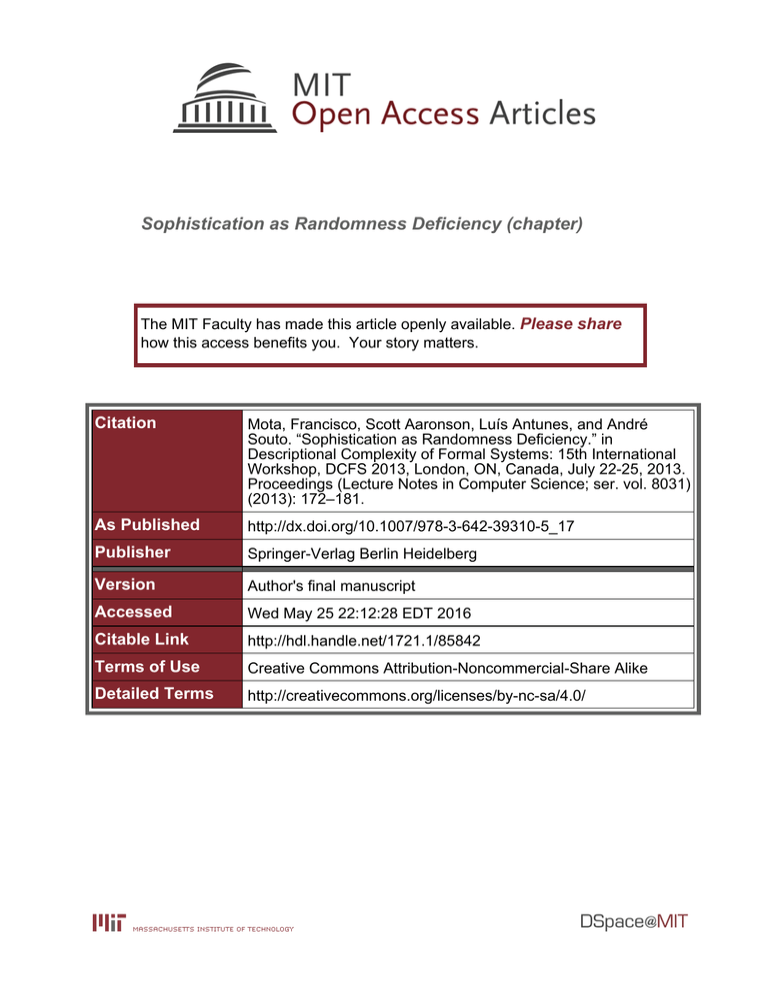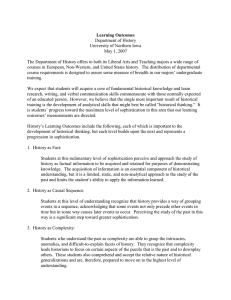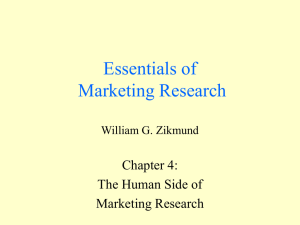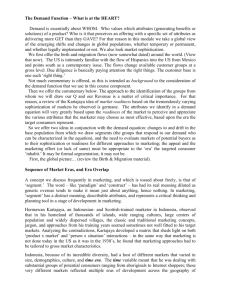Sophistication as Randomness Deficiency (chapter) Please share
advertisement

Sophistication as Randomness Deficiency (chapter)
The MIT Faculty has made this article openly available. Please share
how this access benefits you. Your story matters.
Citation
Mota, Francisco, Scott Aaronson, Luís Antunes, and André
Souto. “Sophistication as Randomness Deficiency.” in
Descriptional Complexity of Formal Systems: 15th International
Workshop, DCFS 2013, London, ON, Canada, July 22-25, 2013.
Proceedings (Lecture Notes in Computer Science; ser. vol. 8031)
(2013): 172–181.
As Published
http://dx.doi.org/10.1007/978-3-642-39310-5_17
Publisher
Springer-Verlag Berlin Heidelberg
Version
Author's final manuscript
Accessed
Wed May 25 22:12:28 EDT 2016
Citable Link
http://hdl.handle.net/1721.1/85842
Terms of Use
Creative Commons Attribution-Noncommercial-Share Alike
Detailed Terms
http://creativecommons.org/licenses/by-nc-sa/4.0/
Sophistication as Randomness Deficiency
Francisco Mota1,2 , Scott Aaronson4 , Luı́s Antunes1,2 , and André Souto1,3
1
Security and Quantum Information Group at Instituto de Telecomunicações
< fmota@fmota.eu, lfa@dcc.fc.up.pt, asouto@math.ist.utl.pt >
2
Departamento de Ciência de Computadores at FCUP
3
Departamento de Matemática at IST at UTL
4
Computer Science and Artificial Intelligence Lab at MIT
< aaronson@csail.mit.edu >
Abstract. The sophistication of a string measures how much structural
information it contains. We introduce naive sophistication, a variant of
sophistication based on randomness deficiency. Naive sophistication measures the minimum number of bits needed to specify a set in which the
string is a typical element. Thanks to Vereshchagin and Vitányi, we know
that sophistication and naive sophistication are equivalent up to low order terms. We use this to relate sophistication to lossy compression,
and to derive an alternative formulation for busy beaver computational
depth.
1
Introduction
Kolmogorov complexity measures the amount of information intrinsic in an object by measuring how much an object can be compressed. For example, the
string 01000 (that is, 0 repeated 1000 times) can be compressed into only a few
bits and therefore has very little information. On the other hand, a random
string cannot easily be compressed and therefore has a lot of information.
Di↵erent methods of compression will yield di↵erent complexity measures.
Fortunately, there is a compression scheme that yields an optimal complexity
measure. The trick is to describe a string x as a pair hp, di, where p is a program
in some prefix-free Turing-complete language, and the program p generates the
string x when given the string d as input. Thus we define the Kolmogorov complexity of x as the length of the shortest description of x under this universal
compression scheme:
K(x) = min{ |p| + |d| : hp, di is a description of x }.
p,d
We say that a string x is incompressible if K(x) |x| O(1). Incompressible
strings are indistinguishable from randomly generated strings, so we equate the
two: a random string is an incompressible string. Furthermore, we know that if
hp, di is an optimal two-part description for x, then d is incompressible. Thus
we say that p represents the structural information of x and d represents the
random information of x.
This sets the stage for the study of sophistication. Sophistication measures
the amount of structural information in a string. We look at all short descriptions
of a string and minimize over the structural information in those descriptions.
An equivalent way to look at sophistication is to model a string by a finite set
that contains it. Some sets are better models than others. Sophistication is then
the minimum complexity of a good model for that string.
For example, the set of all strings of length n is a good way to model completely random strings of length n, so a completely random string has very low
sophistication. On the other hand, the set {x} is always a good model for the
string x, so a string of very low complexity also has very low sophistication.
One of the characteristics of a good model for x is that x must be a typical
element of that model, in the sense that x is generally indistinguishable from
an element of the model taken at random. Randomness deficiency addresses this
question of typicality. Randomness deficiency is used to measure how typical a
string is with respect to a finite set that contains it.
The contributions of this paper are:
– We introduce a sophistication measure based on randomness deficiency, naive
sophistication (§3). Vereshchagin and Vitányi [1] showed that naive sophistication is equivalent to sophistication up to low order terms (§4).
– We relate naive sophistication to the limits of lossy compression, in the sense
that naive sophistication measures how many bits are needed to represent a
consistent model of the string. With a consistent model, we can query the
properties of the string with a very low false positive rate (§5).
– We compare naive sophistication to computational depth (§6). By using
naive sophistication, we establish an alternative definition for busy beaver
computational depth.
2
Preliminaries
In this section we present formal definitions for Kolmogorov complexity, randomness deficiency, discrepancy, and sophistication. What follows is a brief summary
of the theory of Kolmogorov complexity. For more details, we suggest the reading
of [2].
Definition 1 (Kolmogorov Complexity). Let T be a prefix-free Turing machine. We define the conditional Kolmogorov complexity of x given y relative
to T as the length of the shortest program that outputs x when given y as an
additional input:
KT (x|y) = min{ |p| : T (p, y) = x }.
p
There is a prefix-free Turing machine U which yields an optimal prefix-free complexity measure. For any prefix-free Turing machine T , there is a constant cT
2
such that KU (x|y) KT (x|y) + cT . Because U is optimal, we drop the subscript,
and this is what we call the Kolmogorov complexity of x given y:
K(x|y) = KU (x|y) = min{ |p| : U (p, y) = x }.
p
We also use special notation for the case where the condition y is the empty string
". This is equivalent to the definition of K(x) presented in the introduction:
K(x) = K(x|") = min{ |p| : U (p, ") = x }.
p
Kolmogorov complexity measures how much information we need to describe
a string. We can also extend this definition to finite sets of strings, by encoding the set S = {x1 , x2 , . . . , xk } as a string [S] = [k][x1 ][x2 ] · · · [xk ] where the
sequence x1 , . . . , xk enumerates all elements of S in lexicographic order, [k] is a
prefix-free encoding5 of the integer k, and [xi ] is a prefix-free encoding6 of the
string xi . The complexity of a finite set S is then
K(S) = K([S]) = K([k][x1 ][x2 ] · · · [xk ]).
Likewise, we can use a finite set S as the condition in confitional Kolmogorov
complexity. We define K(x|S) = K(x|[S]). Given such a description of a set, we
would need at most log |S| bits to describe any element from the set. That is, if
x 2 S, then K(x|S) log |S| + O(1). By a counting argument, most elements
of S also satisfy K(x|S) log |S| O(1), but there might be a shorter way to
describe x given S, if x is atypical.
Definition 2 (Randomness Deficiency). The randomness deficiency of x
with respect to a finite set S containing x is defined as
(x|S) = log |S|
K(x|S).
An element x of S with low randomness deficiency is said to be typical, for the
best way to describe x using S is to pinpoint its exact location in the set. In this
paper we adopt the convention that if x is not an element of S, then (x|S) = 1.
We could also use S to describe any x 2 S unconditionally, by first describing
S and then pinpointing x’s location in it: K(x) K(S)+log |S|+O(1). However,
the set S might be a very poor model of x, resulting in a large gap between K(x)
and K(S) + log |S|. We introduce discrepancy as a new notation to talk about
this gap.
Definition 3 (Discrepancy). The discrepancy of x with respect to a finite set
S containing x is the additional cost of using S to describe x. It is defined as
(x|S) = log |S|
K(x) + K(S).
By convention, if x is not an element of S, then
5
6
k
(x|S) = 1.
For example, let [k] = 0 1, for any natural number k.
For example, let [x] = [|x|]x = 0|x| 1x, for any string x.
3
Randomness deficiency measures how far x is from being a typical element of
S, and discrepancy measures how far S is from being a good model of x. They
are two sides of the same coin, and they are simply related. It is easy to see that
(x|S) (x|S) + O(1) for any x and S. The following lemma tells us exactly
how far apart they are, up to a logarithmic term.
Lemma 1. For any finite set of strings S and any string x 2 S, we have
(x|S) = (x|S) + K(S|x)
up to a logarithmic additive term in K(S) and K(x).
Proof. By the symmetry of algorithmic information [3], we know that K(S)
K(S|x) = K(x) K(x|S) up to a logarithmic additive term in K(S) and K(x).
Rearranging the terms and adding log |S| to both sides gives us the desired
approximate equality.
t
u
2.1
Sophistication and Coarse Sophistication
Sophistication, as defined by Koppel [4], measures the amount of structural
information contained in a string. According to Vitányi [5], this is equivalent to
measuring the complexity of a good model for that string, up to low order terms.
Definition 4 (Sophistication). The sophistication of x is the complexity of
the simplest model of x with limited discrepancy:
sophc (x) = min{ K(S) :
S
(x|S) c }.
The significance level c tells us how much discrepancy S is allowed to have. We
say that S is a witness to sophc (x) if K(S) sophc (x) and (x|S) c.
Antunes and Fortnow [6] defined a variant of sophistication, called coarse sophistication, that gets rid of the significance level by incorporating it into the
minimization.
Definition 5 (Coarse Sophistication). The coarse sophistication of a string
x minimizes both the complexity of the model and its discrepancy:
csoph(x) = min{ K(S) +
S
(x|S) }.
Once again, this definition is equivalent to the definition based on structural
information, given in [6], up to a logarithmic additive term. We say that S is a
witness to csoph(x) if K(S) + (x|S) csoph(x).
What follows is an alternative definition for coarse sophistication.
Lemma 2. We have:
csoph(x) = min{ sophc (x) + c }.
c
4
Proof.
(x|S) c.
() For any c, let S be a witness to sophc (x). By definition,
Therefore,
csoph(x) K(S) +
(x|S) sophc (x) + c.
Since this is true for any c, we have csoph(x) minc { sophc (x) + c }.
( ) Let S be a witness to csoph(x) and let d =
(x|S). Therefore,
minc { sophc (x) + c } sophd (x) + d
K(S) +
(x|S)
= csoph(x).
3
t
u
Naive Sophistication
We now define a sophistication measure based on randomness deficiency.7
Definition 6 (Naive Sophistication). The naive sophistication of x is the
complexity of the simplest set in which x is a typical element:
nsophc (x) = min{ K(S) : (x|S) c }.
S
The significance level c tells us how atypical x is allowed to be. We say that S
is a witness to nsophc (x) if K(S) nsophc (x) and (x|S) c.
Definition 7 (Naive Coarse Sophistication). Naive coarse sophistication
gets rid of the significance level, by minimizing over both the complexity of the
set and the resulting randomness deficiency:
ncsoph(x) = min{ K(S) + (x|S) }.
S
We say that S is a witness to ncsoph(x) if K(S) + (x|S) ncsoph(x).
Naive coarse sophistication is the naive counterpart to coarse sophistication.
Lemma 2 also applies to naive coarse sophistication. In other words, the following
equation is an equivalent definition for naive coarse sophistication:
ncsoph(x) = min{ nsophc (x) + c }.
c
7
Aaronson first introduced naive sophistication in his MathOverflow question [7].
5
4
Comparing Sophistication Measures
In this section, we show that naive sophistication is equivalent to sophistication
up to low order terms, based on previous work by Vereshchagin and Vitányi [1].
These equations and inequalities hold up to a logarithmic additive term in |x|:
sophc+O(log |x|) (x) nsophc+O(1) (x) sophc (x),
csoph(x) = ncsoph(x).
Theorem 1. Naive sophistication is a lower bound for sophistication:
nsophc+O(1) (x) sophc (x),
ncsoph(x) csoph(x) + O(1).
Proof. This is a consequence of (x|S)
(x|S) + O(1) for any x and S.
t
u
Lemma 3 (Lemma A.4 of [1]). For any finite set A containing x with K(A)+
log |A| O(|x|), then there is a finite set S containing x with K(S) K(A)
K(A|x) + O(log |x|) and log |S| log |A|.
Theorem 2. Naive sophistication is an upper bound for sophistication:
sophc+O(log |x|) (x) nsophc (x) + O(log |x|),
csoph(x) ncsoph(x) + O(log |x|).
Proof. Let A witness nsophc (x). By Lemma 3, there is a set S with K(S)
K(A) K(A|x) + O(log |x|) and log |S|. Therefore,
(x|S) = K(S) + log |S|
K(x)
(K(A) K(A|x) + O(log |x|)) + log |A|
(x|A) K(A|x) + O(log |x|)
(x|A) + O(log |x|)
K(x)
(by Lemma 1)
c + O(log |x|).
Therefore sophc+O(log |x|) (x) K(S) nsophc (x) + O(log |x|). The csoph(x)
upper bound follows by Lemma 2.
t
u
We can also use naive sophistication to create an upper bound for sophistication that uses a O(1) additive term in the significance level, but it is significantly
weaker.
Theorem 3 (Upper bound for sophistication with constant overhead).
sophnsophc (x)+c+O(1) (x) nsophc (x),
csoph(x) 2 · nsophc (x) + c + O(1).
6
Proof. Let S be a witness to nsophc (x). Notice that log |S| K(x|S) + c, that
K(S) = nsophc (x), and that K(x|S) K(x) + O(1). We have,
(x|S) K(S) + log |S|
K(x)
K(S) + K(x|S) + c
K(x)
K(S) + c + O(1)
= nsophc (x) + c + O(1).
t
u
The csoph(x) upper bound follows by Lemma 2.
5
Relation to Lossy Compression
Naive sophistication measures the limits of lossy compression. This is true in the
sense that we need only a witness to nsophc (x) to be able to query properties of
x without false positives, and we need at least nsophc+O(1) (x) bits to describe
any such model of x. The connection between lossy compression and randomness
deficiency was established in [1]. We are elaborating on that connection.
Let us say that a set S is (c, x)-consistent if and only if, for all properties
P ✓ ⌃ ⇤ , if P occurs with high probability in S, then x 2 P . Formally, S is
(c, x)-consistent if for all properties P ,
Pr(P )
S
1
2
c K(P |S)
implies
x 2 P.
Theorem 4. Consistency is equivalent to randomness deficiency, up to a constant d:
1. A set S is (c, x)-consistent if (x|S) c d.
2. A set S is (c, x)-consistent only if (x|S) c + d.
Proof.
1. Let S satisfy (x|S) c d. We will show that S is (c, x)-consistent. Let
P ✓ ⌃ ⇤ be a property that occurs with high probability in S. That is,
PrS (P ) 1 2 c K(P |S) . Let Q = S \ P . Then |Q| < |S| · 2 c K(P |S) . If
x 2 Q, we have
K(x|S) K(Q|S) + log |Q|
< (K(P |S) + O(1)) + (log |S|
log |S|
c + O(1).
c
K(P |S))
This implies (x|S) > c O(1), which is a contradiction for large enough
values of d. Therefore x 2 P . This holds for all properties P that occur with
high probability in S, so S is (c, x)-consistent.
7
2. We know that for any property P with PrS (P ) 1 2 c K(P |S) , we have
x 2 P . By way of contradiction, let us assume that (x|S) > c + d. That
is, K(x|S) < log |S| c d. Let P = { y : y 6= x }. Note that K(P |S)
K(x|S) + O(1) K(x|S) + d log |S| c, for large enough values of d. We
have
PrS (P ) = (|S|
1)/|S|
=1
1/|S|
=1
2
log |S|
1
2
c K(P |S)
.
Since S is (c, x)-consistent and P occurs with high probability in S, we have
x 2 P . But by construction, x 62 P . Therefore, (x|S) c + d.
t
u
As a result, nsophc (x) roughly measures the minimum complexity of (c, x)consistent sets. Also, if S is a witness to nsophc (x), we can use S to infer
information about x. If we want to see if x has a property P , we take many
elements of S at random. If all of those elements are in P , then it is very likely
that x is in P as well. Otherwise, we cannot tell whether x 2 P or x 62 P . That
is, witnesses to naive sophistication generally only prevent false positives, not
false negatives.
6
Relation to Computational Depth
Computational depth measures how much harder compression is in the presence
of time bounds:
deptht (x) = K t (x) K(x)
where K t (x) = minp { |p| : U (p, ") = x in at most time t } is the time-bounded
Kolmogorov complexity. It is well known that sophistication and computational
depth are related [4, 6], as are computational depth and randomness deficiency
[8]. Antunes and Fortnow [6] used busy beaver computational depth:
depthBB (x) = min{ K(t) + deptht (x) }.
t
They showed that coarse sophistication is equivalent to busy beaver computational depth, up to a logarithmic additive term:
csoph(x) ⇡ depthBB (x).
We can show a similar result about naive sophistication and how it relates to
a variant of busy beaver computational depth, but first we need to strengthen
symmetry of information with explicit time bounds.
Lemma 4 (Time-bounded symmetry of information). Symmetry of information still holds in the presence of a time bound, but the time bound increases.
Let t be a time bound. Then there exists a t0 t such that
0
0
K t (y) + K t (x|y) K t (x, y) + O(log K t (x, y)).
8
Furthermore, t0 =
· t log t where K( ) O(log K t (x, y)).
Proof. Let m = K t (x, y). Let V = { v : K t (v, y) m }, and U = { u :
9 |V | v. K t (v, u) m }. Note that |U | 2m /|V |, that x 2 V and y 2 U , and
that both V and U are enumerable in time t0 = 22m+O(1) · t log t, and we have
K(22m+O(1) ) O(log m). Finally, we have,
0
0
0
0
K t (y) + K t (x|y) (K t (U ) + log |U |) + (K t (V |y) + log |V |) + O(1)
log |U | + log |V | + O(log m)
(m
k) + k + O(log m)
t
K (x, y) + O(log K t (x, y)).
t
u
Theorem 5 (Naive sophistication as computational depth). Up to a logarithmic additive term, we have:
ncsoph(x) = min{ K(t) + deptht (x|t) }.
t
Proof.
() Let t minimize the right-hand side. Let k = K t (x|t), and let S = { y :
K t (y|t) k }. We have log |S| k and K(S|t) K(k) O(log |x|). Therefore,
ncsoph(x) K(S) + log |S|
K(x|S)
(K(t) + O(log |x|)) + k
t
K(t) + K (x|t)
O(log |x|))
(K(x|t)
K(x|t) + O(log |x|).
( ) Let S be a witness to ncsoph(x). Let t be a time bound sufficiently large in
order to describe S fully, pick any given element from it, and also to return
t, in such a way that K t (x, t) K(S) + log |S| + O(1). For any S, we can
construct such a t, so K(t|S) O(log |x|). Using Lemma 4, we obtain a time
0
bound t0 such that K(t) + K t (x|t) K t (x, t) + O(log |x|), with K(t0 |t) =
O(log |x|) and K(t|t0 ) = O(log |x|). We extend this with a time bound t00 =
00
0
c · t0 for some constant c, such that K t (x|t00 ) K t (x|t) + O(log |x|). As a
result, we have,
mint { K(t) + K t (x|t)
00
K(x|t) } K(t00 ) + K t (x|t00 )
0
K(t) + K t (x|t)
t
K (x, t)
K(x|t00 )
K(x|t) + O(log |x|)
K(x|t) + O(log |x|)
K(S) + log |S|
K(x|S) + O(log |x|)
= ncsoph(x) + O(log |x|).
t
u
This reveals an alternative definition for busy beaver computational depth, that
holds up to a logarithmic additive term:
depthBB (x) = min{ K(t) + deptht (x) }
t
⇡ min{ K(t) + deptht (x|t) }.
t
9
7
Conclusion
We have defined naive sophistication, a variant of sophistication based on randomness deficiency, and we have seen that it is equivalent to sophistication up
to low order terms. Naive sophistication gives us a new perspective on sophistication and allows us to apply it in new ways, as we have done in looking at
lossy compression and computational depth through new eyes. We have seen that
naive sophistication arises naturally in trying to measure how much information
of a string we can throw away without losing the ability to query its properties
(without false positives). We have also seen that naive sophistication allows us
to find an alternative definition for busy beaver computational depth.
8
Acknowledgements
We wish to thank Péter Gács, Paul Vitányi, and the anonymous reviewers
for their insightful comments. This work was partially supported by the national science foundation of Portugal, Fundação para a Ciência e Tecnologia,
through the project CSI2 with the reference PTDC/EIA-CCO/099951/2008 and
through grants of the Instituto de Telecomunicações. André Souto was also
supported by Fundação para a Ciência e Tecnologia through the scholarship
SFRH/BPD/76231/2011.
References
1. Vereshchagin, N., Vitányi, P.: Kolmogorov’s structure functions and model selection.
IEEE Transactions on Information Theory 50(12) (2004) 3265–3290
2. Li, M., Vitányi, P.: An introduction to Kolmogorov complexity and its applications.
3rd edn. Springer-Verlag (2008)
3. Gács, P.: On the symmetry of algorithmic information. Soviet Mathematics Doklady
15 (1974) 1477–1480
4. Koppel, M.: Structure. In Herken, R., ed.: The Universal Turing Machine: a HalfCentury Survey. Oxford University Press (1988) 435–452
5. Vitányi, P.: Meaningful information. IEEE Transactions on Information Theory
52(10) (2006) 4617–4626
6. Antunes, L., Fortnow, L.: Sophistication revisited. Theory of Computing Systems
45(1) (2009) 150–161
7. Aaronson, S.: Can a string’s sophistiocation be defined in an unsophisticated way?
(2012)
8. Antunes, L., Matos, A., Souto, A., Vitányi, P.: Depth as randomness deficiency.
Theory of Computing Systems 45(4) (2009) 724–739
10





